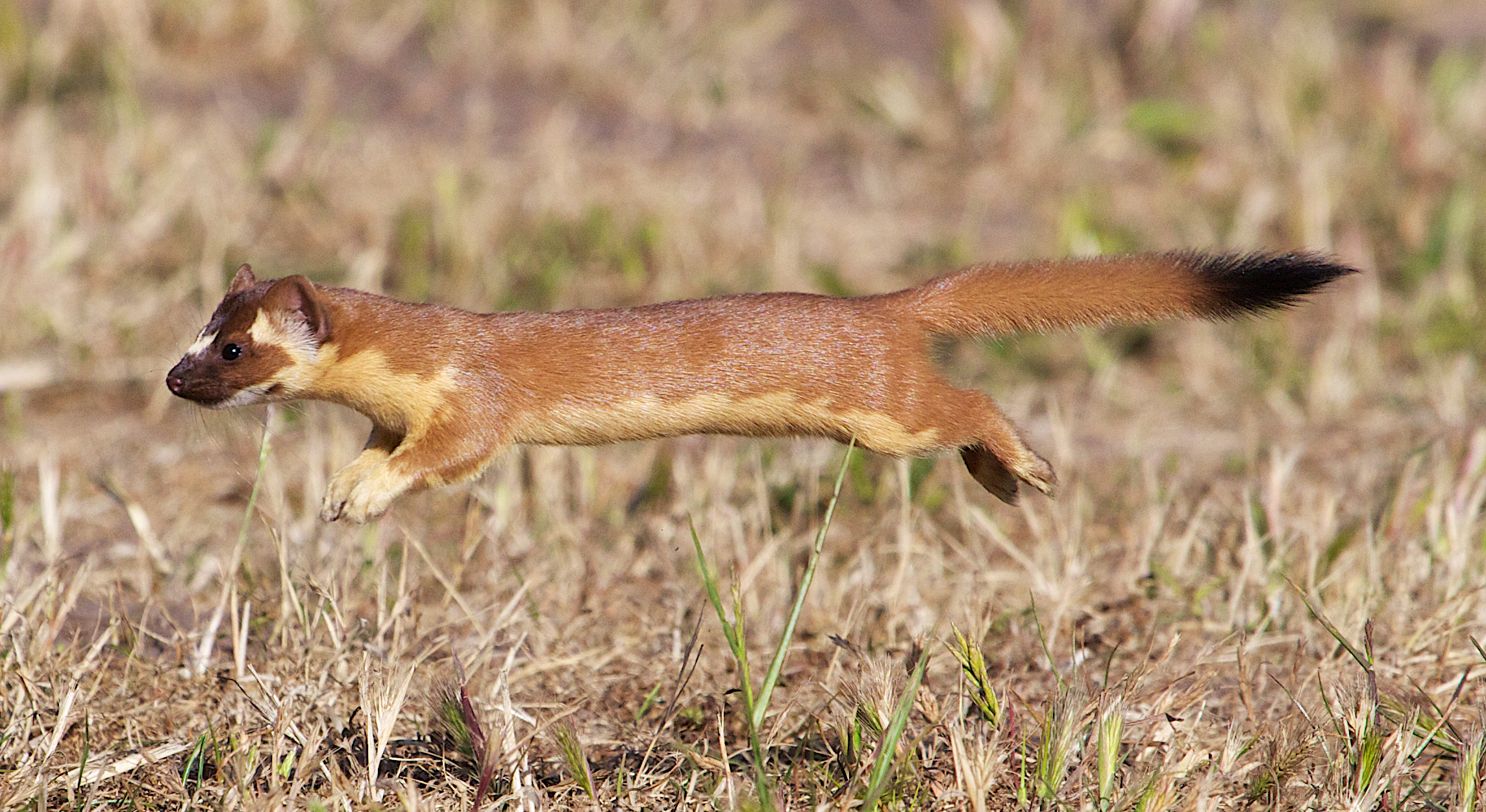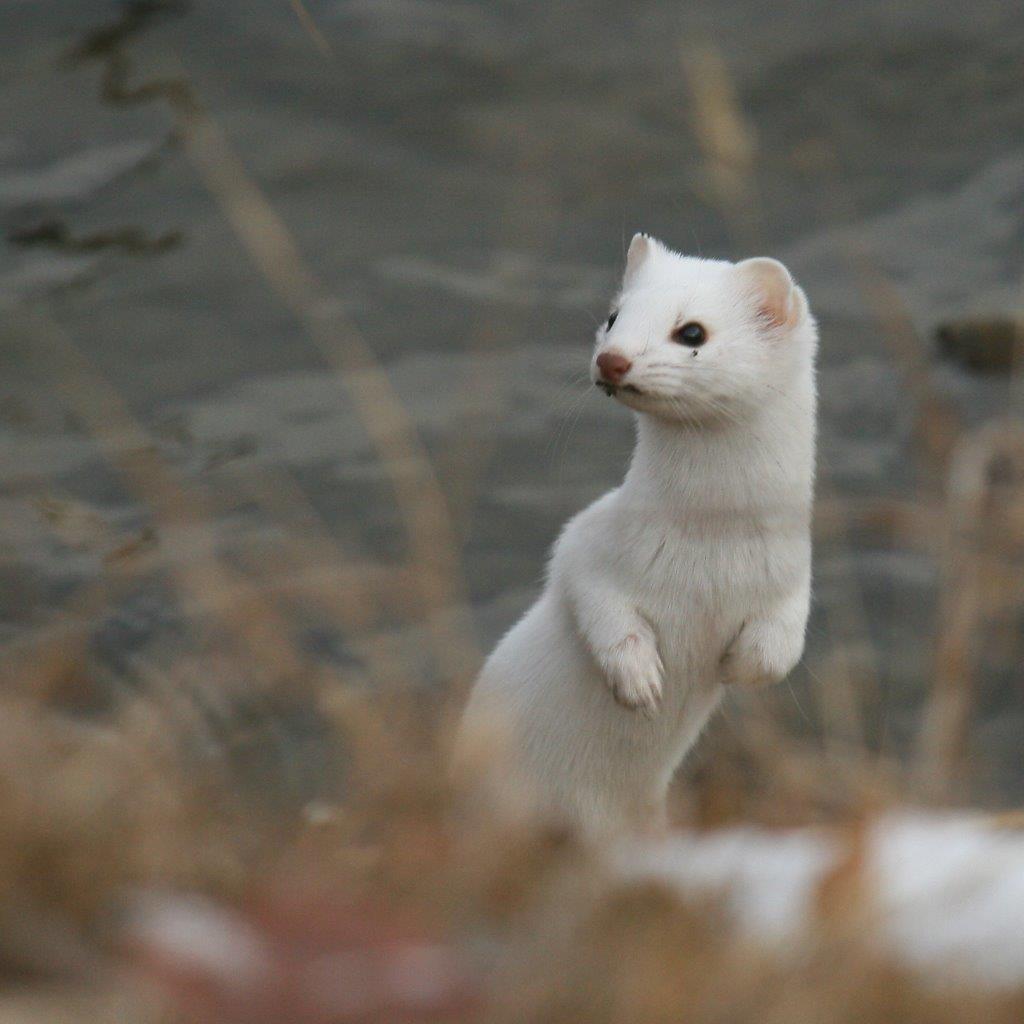Reproduction
The long-tailed weasel, Mustela frenata, has a very
unique breeding pattern. From mid to late summer, the males
begin to search for female weasels to breed with and usually
find a mate through the discharge of a funky, yet attractive
smell from the female (Adirondack Ecological Center 1988; Animal
Diversity Web 2002). Even though the act of mating occurs during
the sum mer months, the gestation period lasts about 205 to 337
days (Adirondack Ecological Center 1988). The implantation of
the egg after sexual intercourse is delayed and most of the
development of the embryo takes place during the last 23 to 27
days of pregnancy, or around the month of March (Adirondack
Ecological Center 1988; Animal Diversity Web 2002). When the
female is ready, she bears a litter with the average size of
five to eight offspring in the months of April or May
(Adirondack Ecological Center 1988). The newborn weasels are
extremely vulnerable during the first few weeks of its life and
are born primarily pink with a few white hairs, are completely
blind and are only three grams (Adirondack Ecological Center
1988; Animal Diversity Web 2002)! By day 36 most of the young weasels
will have opened their eyes and will have begun to wean from
their mother (Adirondack Ecological Center 1988; Animal
Diversity Web 2002). Eventually, the weasels will become
independent and will disperse before the winter months
(Adirondack Ecological Center 1988). Unfortunately, many of the
weasels will die within their first year due to the presence of
predators or a harsh environment (Animal Diversity Web 2002).
For the few that survive, they will have to find a home to take
charge of and will have to develop many characteristics to
interact with their environment.
Click here for more information on interactions! Finally, when the weasel has
settled it will be ready to make offspring of its own. Female
weasels will be sexually mature by their first summer alone and
males will have matured in their second summer alone (Adirondack
Ec
mer months, the gestation period lasts about 205 to 337
days (Adirondack Ecological Center 1988). The implantation of
the egg after sexual intercourse is delayed and most of the
development of the embryo takes place during the last 23 to 27
days of pregnancy, or around the month of March (Adirondack
Ecological Center 1988; Animal Diversity Web 2002). When the
female is ready, she bears a litter with the average size of
five to eight offspring in the months of April or May
(Adirondack Ecological Center 1988). The newborn weasels are
extremely vulnerable during the first few weeks of its life and
are born primarily pink with a few white hairs, are completely
blind and are only three grams (Adirondack Ecological Center
1988; Animal Diversity Web 2002)! By day 36 most of the young weasels
will have opened their eyes and will have begun to wean from
their mother (Adirondack Ecological Center 1988; Animal
Diversity Web 2002). Eventually, the weasels will become
independent and will disperse before the winter months
(Adirondack Ecological Center 1988). Unfortunately, many of the
weasels will die within their first year due to the presence of
predators or a harsh environment (Animal Diversity Web 2002).
For the few that survive, they will have to find a home to take
charge of and will have to develop many characteristics to
interact with their environment.
Click here for more information on interactions! Finally, when the weasel has
settled it will be ready to make offspring of its own. Female
weasels will be sexually mature by their first summer alone and
males will have matured in their second summer alone (Adirondack
Ec ological Center 1988). The potential lifespan of this long-tailed weasel is around
five years so successful reproduction is
vital to the continuance of this species survival.
ological Center 1988). The potential lifespan of this long-tailed weasel is around
five years so successful reproduction is
vital to the continuance of this species survival.
Mustela frenata is a mammalian species and thus produces offspring which are reliant on the mammalian glands of the mother. Being in this group, weasels are characterized by having a gametic lifestyle. In this life cycle, the dominant stage is the diploid phase in which the organism has two sets of chromosomes and is the living weasel we all know and see. For reproduction to occur though, the offspring must gain a pair of chromosomes from each parent. For this to happen, the organism must develop special sex cells called gametes. These cells are formed through the process of meiosis in which diploid cells are converted to haploid cells which contains one set of chromosomes. So, when the act of mating occurs the haploid egg from the mother and the haploid sperm cell from the father unite during fertilization to create a diploid zygote that will eventually develop into a grown weasel. Unlike humans, it is natural for weasels to have around six offspring since multiple eggs are fertilized at once. This ability allows for a greater chance of survival for weasels since more offspring have the ability to pass on their traits. For other adaptions click here!
Back to Adaption Go to Interactions
